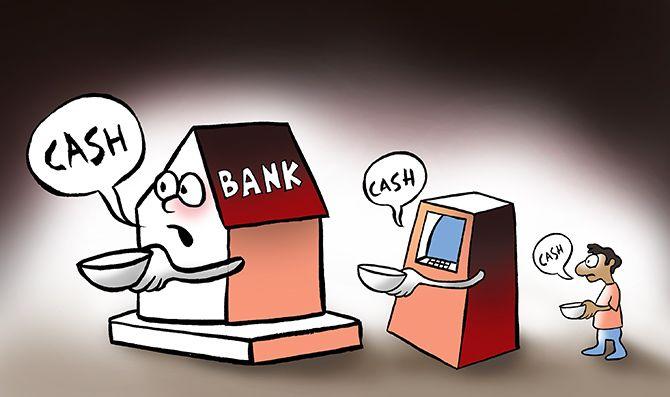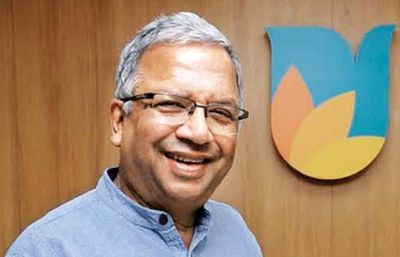'We provide unsecured loans of Rs 150,000-500,000 and secured loans of Rs 10 lakh-Rs 25 lakh.
'These are largely small businesses, traders, services and some manufacturing units.'
Illustration: Uttam Ghosh/Rediff.com

A well-run non-banking company has better margins than a bank, but the objective of setting up Ujjivan was to provide comprehensive financial inclusion, Ujjivan Small Finance Bank MD & CEO Samit Ghosh, bottom, left, tells Anup Roy in an interview. Edited excerpts:
How has becoming a small finance bank helped Ujjivan?
We can now offer a full range of products. As a microfinance institution (MFI), there were restrictions in terms of raising deposits and offering other products such as insurance, etc.
Purely from a profitability perspective, a well-run non-banking company has better margins than a bank.
But the objective of setting up Ujjivan was to provide comprehensive financial inclusion.
What are your plans for this year?
This will be the first year since demonetisation when we can focus entirely on building the bank.
Earlier, we were a mono-line business of microfinance. Today, we also have housing, micro and small enterprise (MSE) customers, branch, deposits, wholesale deposits, treasury and third-party products like insurance.
We have about 180 bank branches and 450 MFI branches.
This year, we plan to convert most of them into bank branches. We will open brick-and-mortar branches in rural areas because we can deliver the services to rural masses better.
How did demonetisation affect your business?
The rural economy is mainly cash-driven. If there is disruption in their cash flow for two months, they get hurt.
A lot of our customers are labourers in unorganised sectors. They lost their jobs.
 We were badly affected during that time. Our portfolio risk went from 0.5 per cent to 10 per cent during that period. Repayment rate dropped to about 80 per cent.
We were badly affected during that time. Our portfolio risk went from 0.5 per cent to 10 per cent during that period. Repayment rate dropped to about 80 per cent.
The block of loans that got impacted was about Rs 310 crore in write-offs and provisions.
Will you be able to maintain net interest margins (NIMs) of over 10 per cent in future?
As we get into housing, MSE loans, etc, our NIMs will keep declining. There will be a lot of pressure to reduce our lending rate also when we reduce our cost of borrowing. The RBI will monitor that very closely.
What’s your MSE strategy?
We provide unsecured loans of Rs 150,000-500,000 and secured loans of Rs 10 lakh-Rs 25 lakh. These are largely small businesses, traders, services and some manufacturing and the loans are for working capital, capital expenditure and debt consolidation.
What are your plans on the liability side?
In the first year, because of the preoccupation with demonetisation, we were largely raising wholesale deposits. About 90 per cent of our Rs 3,770 crore deposit base is wholesale.
Still, it is cheaper than the bank borrowing we had to depend on as an MFI.
Our cost of funds has come down by 140 basis points. This year, we will go all out and build a retail business. Our cost of funds should come down by another 100 basis points.
We want to convert about half of our four million microfinance customers and get them to open savings accounts.
We are seeing a traction in retail deposits, where the interest rate is high at 8-8.5 per cent.
This year we want to scale up the deposit base to over Rs 80 billion, of which 20-25 per cent would be retail.
Any plan to change your borrower profile?
Over five years, the microfinance business should come down to 50 per cent. We will grow the business at 15-20 per cent a year.
The other half will be taken up by affordable housing, MSE and personal loans.
How is the affordable housing segment opportunity?
Affordable housing finance has become very crowded; not all players will survive.
Most of the poor live in the periphery of cities and towns, and the documentation and title deeds in most cases are imperfect.
Under banking regulations, we can lend only if all buildings are approved. Who will give approval in these places?
And, this is the bulk of the affordable housing market in India. This is an issue that we are taking up with the RBI and government.
Why brick-and-mortar branches when the focus is digitisation?
The segment we want to serve, our research tells us, wants to see an establishment where they can deposit their money.
They are fine getting their loans serviced at doorsteps, but in rural areas people will not deposit their money to an entity that doesn’t have a physical presence.
The trust only comes when they see a physical branch. At the same time, our branches are hi-tech.
This segment of customers is not savvy enough to transact on a mobile.
So, they want the branch there and the first thing that they ask for are ATMs, as most of their transactions are in cash and they want 24x7 access.











